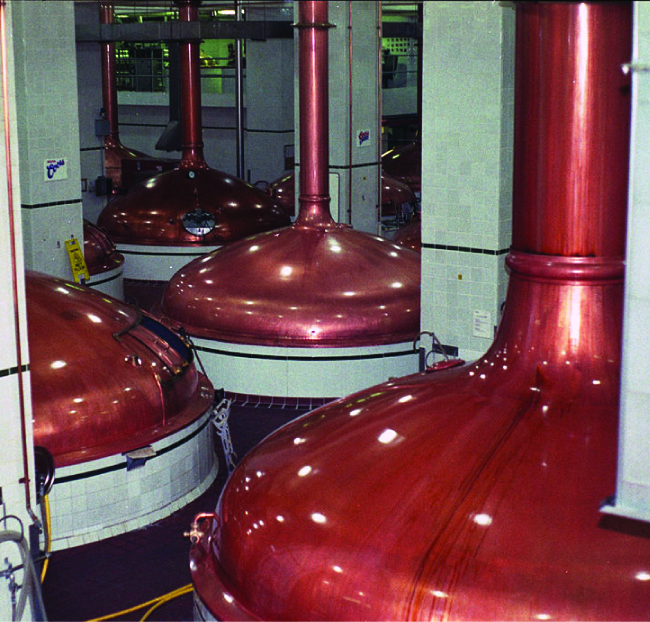Example 3.12: Determining an Empirical Formula from Percent Composition
The bacterial fermentation of grain to produce ethanol forms a gas with a percent composition of 27.29% C and 72.71% O (Figure 3). What is the empirical formula for this gas? Figure 13: An oxide of carbon is removed from these fermentation tanks through the large copper pipes at the top. (credit: “Dual Freq”/Wikimedia Commons)
Figure 13: An oxide of carbon is removed from these fermentation tanks through the large copper pipes at the top. (credit: “Dual Freq”/Wikimedia Commons)
Solution
\(f_{\mathrm{C}}\) \(= 27.29\ \mathrm{%}\)\(f_{\mathrm{O}}\) \(= 72.71\ \mathrm{%}\)
\(\mathrm{ratio}_{\mathrm{molar}}\) = ?
Since the scale for percentages is 100, it is most convenient to calculate the mass of elements present in a sample weighing 100 g. (The calculation is “most convenient” because if a compound contains 27.29% carbon by mass, a 100-g sample will contain 27.29 g of carbon, and so on for the other elements. This makes it easier to follow the calculation in your head, but you would get the same answer for any mass you decide to start with because in the end, this mass cancels out.)
\(m_{\mathrm{total}}\) \(= 100\ \mathrm{g}\)
\(m_{\mathrm{C}}\) \(= f_{\mathrm{C}} \cdot m_{\mathrm{total}}\)
\(\ \ \ =27.29\ \mathrm{%} \cdot 100\ \mathrm{g}\)
\(\ \ \ =27.29\ \mathrm{g}\)
\(m_{\mathrm{O}}\) \(= f_{\mathrm{O}} \cdot m_{\mathrm{total}}\)
\(\ \ \ =72.71\ \mathrm{%} \cdot 100\ \mathrm{g}\)
\(\ \ \ =72.71\ \mathrm{g}\)
To get the molar ratio, we have to calculate the chemical amounts of carbon and oxygen present.
\(n_{\mathrm{C}}\) \(= \dfrac{m_{\mathrm{C}}}{M_{\mathrm{\ce{C}}}}\)
\(\ \ \ =\dfrac{27.29\ \mathrm{g}}{12.011\ \frac{\mathrm{g}}{\mathrm{mol}}}\)
\(\ \ \ =2.2721\ \mathrm{mol}\)
\(n_{\mathrm{O}}\) \(= \dfrac{m_{\mathrm{O}}}{M_{\mathrm{\ce{O}}}}\)
\(\ \ \ =\dfrac{72.71\ \mathrm{g}}{15.999\ \frac{\mathrm{g}}{\mathrm{mol}}}\)
\(\ \ \ =4.5447\ \mathrm{mol}\)
Coefficients for the tentative empirical formula are derived by dividing each molar amount by the lesser of the two:
\(\mathrm{coeff}_{\mathrm{C}}\) \(= \dfrac{n_{\mathrm{C}}}{\mathrm{min}(n_{\mathrm{C}}, n_{\mathrm{O}})}\)
\(\ \ \ =\dfrac{2.2721\ \mathrm{mol}}{\mathrm{min}(2.2721\ \mathrm{mol}, 4.5447\ \mathrm{mol})}\)
\(\ \ \ =\dfrac{2.2721\ \mathrm{mol}}{2.27208\ \mathrm{mol}}\)
\(\ \ \ =100.00\ \mathrm{%}\)
\(\mathrm{coeff}_{\mathrm{O}}\) \(= \dfrac{n_{\mathrm{O}}}{\mathrm{min}(n_{\mathrm{C}}, n_{\mathrm{O}})}\)
\(\ \ \ =\dfrac{4.5447\ \mathrm{mol}}{\mathrm{min}(2.2721\ \mathrm{mol}, 4.5447\ \mathrm{mol})}\)
\(\ \ \ =\dfrac{4.5447\ \mathrm{mol}}{2.27208\ \mathrm{mol}}\)
\(\ \ \ =200.02\ \mathrm{%}\)
Since the resulting ratio is one carbon to two oxygen atoms, the empirical formula is \(\ce{CO2}\).